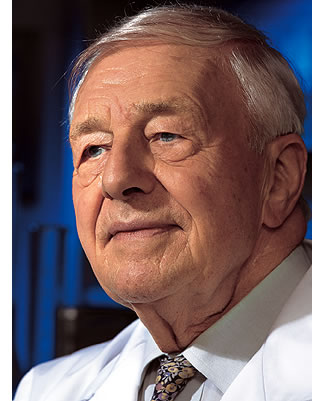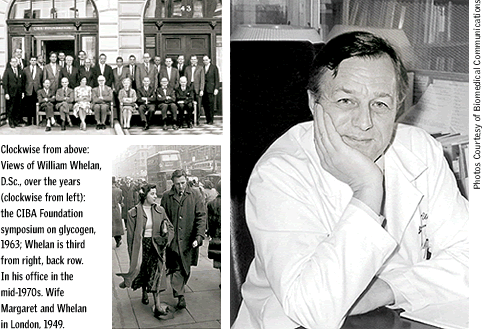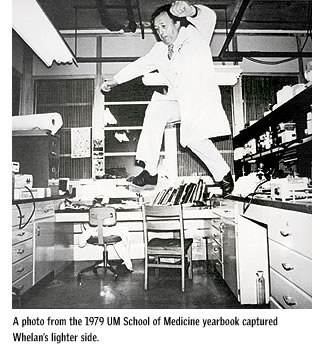 For
some scientists, the “eureka!” moment
comes early and easily. Others labor for years until the
right combination of persistence and circumstances collide.
William J. Whelan, D.Sc., is one of the latter. For
some scientists, the “eureka!” moment
comes early and easily. Others labor for years until the
right combination of persistence and circumstances collide.
William J. Whelan, D.Sc., is one of the latter.
Whelan, professor of biochemistry and molecular
biology and chairman emeritus of the University of Miami
Miller School
Of Medicine’s Department of Biochemistry and Molecular
Biology, began researching starch and glycogen synthesis
in 1950.
Glycogen is a stored form of glucose, or sugar,
used by the body for energy and for maintaining the level
of blood glucose.
Whelan’s discovery of glycogenin provided the missing
link in the biosynthetic pathway for how glucose is turned
into glycogen, the answer to a puzzle that had baffled other
investigators for a century. His work and the techniques
he developed for isolating and characterizing molecular structures
like glycogen have become scientific standards.
“I’m
a great believer in luck, and I find the harder I work
the more I have
of it.” —Thomas
Jefferson
In 1992 Whelan was named a fellow of the Royal
Society, one of the highest honors granted in the scientific
community. In 2006 he received the University of Miami’s
Distinguished Faculty Scholar Award for lifetime achievement
in research. In the five decades between launching his research
and receiving this distinguished recognition, he endured
skepticism, dead ends, and lost funding. Today, Whelan’s
discovery of the primer for glycogen synthesis is an accepted
principle included in almost all biochemistry textbooks.
He credits his accomplishments to determination, talented
colleagues, and just plain good luck. “This is a story
of serendipity—a succession of lucky experiences every
practicing scientist will be familiar with,” Whelan
says.
Luck has been with Whelan his whole life,
he says. The eldest of four children raised near Manchester,
England, during
the Depression, he was lucky enough to have a teacher in
school who cultivated his interest in biochemistry. Whelan’s
father, an immigrant from Ireland, made the skins for sausages;
his mother was a housewife. Whelan became the first in his
family to pursue a higher education.
Whelan received one of three countrywide scholarships
from the Brewer’s Society for the University of Birmingham,
where he was to study the science of brewing. But here serendipity
intervened: World War II had arrived, and the scholarship
recipients would have to enroll in the army unless they studied
chemistry instead of brewing. “We did not have freedom
of choice of topic for our beginning graduate studies and
were allocated them apparently at random. A school friend
who had come with me to Birmingham, also with the intent
to become a biochemist, was put to work on something that
only after the war was over did we get to know was part of
the Manhattan Project [the secret U.S. project to create
the atomic bomb]. He never did become a biochemist,” Whelan
recalls.
Whelan was put to work with the Royal Navy
on an antisubmarine detection device, the Asdic Recorder,
which is still used
in the fishing industry today. After the war ended, while
still a graduate student, Whelan became a member of the university’s
faculty, “free to pursue my desire to become a biochemist.” He
began to focus on the enzymology, or the biochemical nature
and activity, of glycogen and starch.
‘There Still Seemed to Be Plenty
to Do’
Before she passed away in 1993, Whelan’s wife, Margaret,
used to greet him as he returned home, “Discover anything
nice today?” For a long time, Whelan had to answer
in the negative.

He spent several frustrating years pursuing
an angle in the study of glycogen and starch “that had to be right—we
knew it had be right,” but that fellow scientists and
funding agencies, including the National Institutes of Health
(NIH), said was absolutely wrong.
Enzymes (mostly proteins) control metabolism. “Enzymes
bring about the chemical transformations of life, outside
and inside the cell,” says Whelan.
“My aim was to use enzymes to explore the structures
of large carbohydrates, such as starch, and its animal counterpart,
glycogen.” New technology that was just becoming available
enabled Whelan to prepare a series of small molecules of
known structures that he could use in order to learn how
they were broken down by the starch-splitting enzymes. With
that knowledge, he could now use the enzymes on starch and
glycogen.
When Whelan first began working on glycogen
and starch, Carl and Gerty Cori had won the 1947 Nobel Prize
in Physiology
or Medicine for their synthesis of glycogen, the process
by which the body converts glucose into glycogen, the form
in which sugar is stored. They identified and purified
a number of the enzymes involved in glucose metabolism, and
their work ultimately advanced scientific understanding
of
metabolic regulation.
“I recall in the ’50s being asked what I was
working on. When I replied glycogen and starch, the response,
as
often as not, having in mind the Cori discoveries, would
be: ‘But that’s all sewn up!’” So
in effect, Whelan had “unwittingly entered a field
of research that was considered a dead end.
“I was not put off by this. There still seemed to be
plenty to do,” Whelan says.
So in 1963 Whelan persuaded the CIBA Foundation
(now known as the Novartis Foundation) to organize a symposium
in London
to explore findings in glycogen research. The historic meeting,
which brought together past and future Nobel Prize winners
along with other top scientists, showed “that the field
was far from moribund.” Inspired by the discussions
of glycogen, Whelan began searching for the missing component
of the glycogen synthesizing system, the primer that would
switch on glycogen synthesis.
“It’s the equivalent to an ignition key in an
automobile—the
engine won’t turn on unless the key is turned,” Whelan
explains. Similarly, glycogen synthesis would not occur without
a primer to set the process into motion.
Whelan and other scientists disproved the
previous theories of primers that had floated about in the
aftermath of the
CIBA Foundation symposium. But they also lacked any new
notion about what might be triggering the process.
Working with international collaborators,
Whelan began to pursue the idea that the primer was a protein,
and not, as
had been supposed, a carbohydrate. In 1980 a young biochemist
named Joseph Lomako, who was visiting Whelan’s lab
for a year, succeeded in isolating the protein from glycogen.
They named it glycogenin.
After such a significant discovery, Whelan
fully expected the NIH to renew the funding that had paid
for this research.
He was wrong.
First Denied, then Celebrated
In 1967 Whelan, then a world-renowned scientist,
joined the faculty at the University of Miami Miller School
of Medicine. “Bill
Whelan represented the beginning of major credibility in
the basic sciences for the School of Medicine when he arrived
in 1967,” says Lawrence M. Fishman, M.D., professor
emeritus of medicine. “He was a very well-recognized
scientist before he came here,” says Bernard Fogel,
M.D., dean emeritus of the Miller School. But despite his
reputation and renown, Whelan’s glycogenin discovery
was roundly rejected.
For seven years, from 1980 to 1987, the NIH
disagreed with Whelan’s lab’s findings: “This reviewer
is troubled by the repeated inferences that glycogenin is
the primer for glycogen synthesis,” stated one NIH
critique.
With a graduate student, Ignacio Rodriguez,
Whelan resolved one issue, the answer to which the NIH had
insisted on: Just
what is the chemical bond between glycogen and glycogenin?
It proved difficult to answer—because once elucidated,
it turned out to be a bond that was previously unknown in
animals. But even when this news was conveyed to the NIH,
funding was still denied.
“This happens to everyone who comes up with a new idea,” explains
Whelan. “People are just damn skeptical.”
But the time to convince people—most notably funding
sources—was growing short.
Money began to run out for the project, which
Whelan kept afloat for a time with small grants from industry
for other
projects.
But Whelan’s students were about to graduate, and the
lab would be empty, without funds.
‘ We Could
So Easily Have Given Up’
At that point, Whelan’s wife Margaret came to his aid.
As a faculty member in the United Kingdom, Whelan had accumulated
a small retirement fund that he was entitled to when he reached
60. Margaret suggested spending that money on the lab. Whelan
brought Joseph Lomako back to Miami. With Wie Lomako, Joseph’s
wife, also part of the team, they were able to extend their
findings and finally isolate pure, active glycogenin from
muscle. “Glycogenin was proven to be the primer, an
enzyme that acts on itself, like a surgeon operating on his
own appendix. You cannot imagine the excitement of being
the first to discover something that has been around for
all eternity but never before revealed,” says Whelan.
With this, their work was accepted, and NIH
funding was restored. Four years later, the Royal Society
elected him a fellow,
citing “the elucidation of the role of a protein primer
in the biosynthesis of glycogen.”
“This allowed us to study the structure of glycogen
normally and what it would be like in glycogen storage diseases
(such
as Pompe’s Disease and Cori’s Disease). We determined
that the structure is abnormal in certain glycogen storage
diseases, and from there we could deduce what’s wrong
with the enzymes. Now we know what’s wrong with the
genes in these diseases,” says Frans Huijing, Ph.D.,
professor of biochemistry and molecular biology, who was
recruited to the Miller School of Medicine in 1968 by Whelan.
An Asset to the School
For 24 years Whelan served as chairman of
the Miller School of Medicine’s Department of Biochemistry and Molecular
Biology. He remains a professor of biochemistry and molecular
biology to this day, teaching classes on both the medical
and Coral Gables campuses. His tenure at the school is remarkable
not only for his work in the lab but also in the committees,
councils, and community of the young medical school, which
was only 15 years old when he arrived.

Among his accomplishments were the creation
of the Ph.D. to M.D. program, which ran from 1971 to 1988,
and the founding
of the Miami Winter Symposium, which will be holding its
40th meeting in 2007. The symposia bring Miller School graduate
and postdoctoral students and faculty face-to-face with nationally
and internationally prominent scientists, including several
Nobel Laureates, each year. Since its inception in 1968,
the symposia have only grown in popularity and are now one
of the conferences sponsored by the renowned journal Nature.
“Add my voice to the mountains of praise for Bill Whelan’s
role in putting the biochemistry department in Miami among
the leaders in the U.S. He has done this by shrewdly exploiting
your winter climate to fund winter symposia that are now
a ‘must’ for ambitious young researchers. His
other stroke of genius was to recruit biochemically oriented
staff in other medical departments as honorary members of
his own department. This built alliances that led to the
groundbreaking success of your Ph.D. to M.D. program, which
is universally admired. All this was on top of retaining
his leading research role in the enzymology of carbohydrates,” says
Brian S. Hartley, Ph.D., F.R.S., director for the Centre
for Biotechnology in London’s Imperial College of Science
and Technology.
In addition to those laurels, for over 40
years Whelan has been involved in international biochemical
organizations,
as the secretary general and president of three and the founder
and first editor in chief of several of the most highly cited
biochemical journals. These belong to the not-for-profit
organizations on whose behalf Whelan has worked, and the
royalties they have earned now run into tens of millions
of dollars that support biochemists worldwide.
Now 82, Whelan has decided that he’s going to slow
down, maybe step down from teaching and give up some of his
academic responsibilities, though he’ll still continue
his role as an editor in chief for the International
Union of Biochemistry and Molecular Biology. However, “I
think I’m going to gradually fade away,” Whelan
says.
But Fishman, Huijing, and hundreds of other
colleagues, collaborators, and present and past students
can’t see that happening. “He
is such a dynamic individual,” says Fishman. “Even
in his eighth decade, he’s just beyond most of us intellectually.
“I think Bill Whelan is one of the most important people
in our medical school. He was instrumental in having the
School
of Medicine become a respectable place to do research.”
|